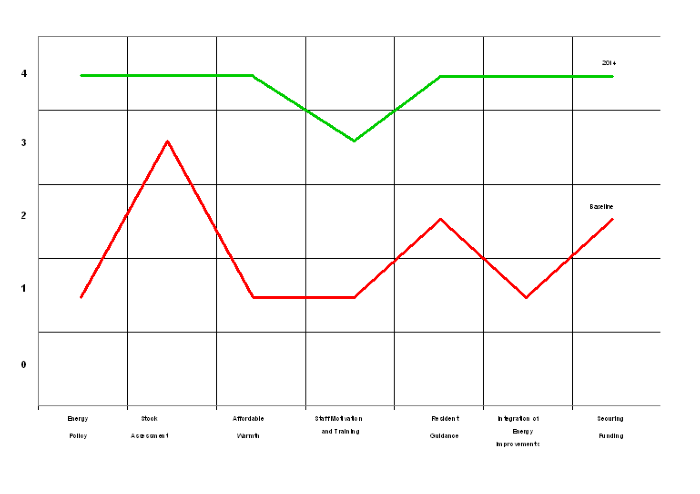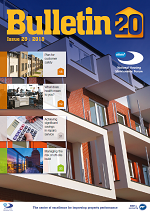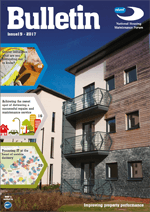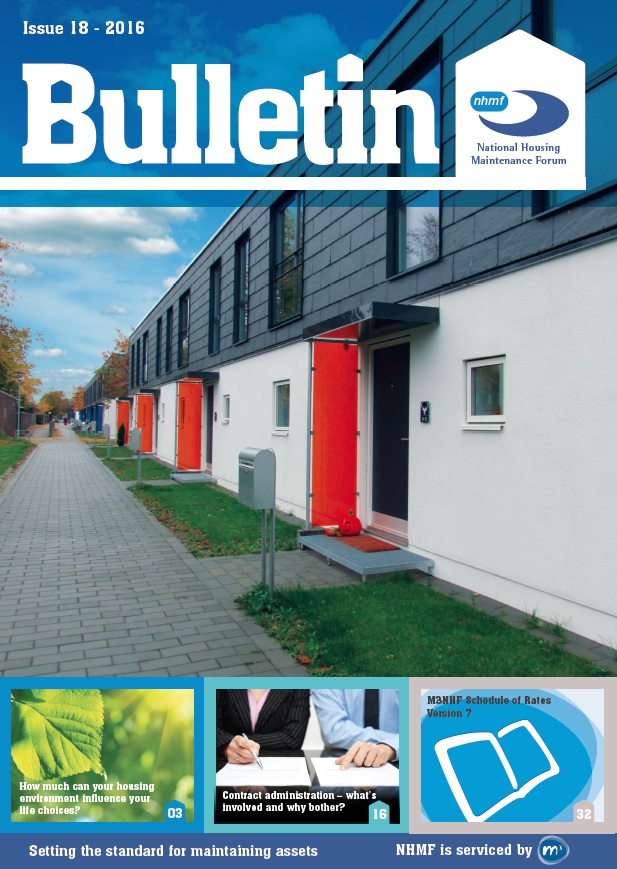NHMF best practice
These two new best practice sections will help social landlords to maintain quality homes in an increasingly challenging economic environment. The Compliance Section has a set of topical guides summarising social landlords’ responsibilities for meeting essential statutory health and safety requirements and explain how to do this economically and efficiently. The Fuel Saving Section explains how to include a fuel saving strategy as a key aspect of an organisation’s business plan. The Guide then sets out how to develop a practical improvement strategy as an integral part of the asset management programme and how to successfully deliver the improvements and manage the risks. There are also best practice training courses which relate to this guide.
Chapter 5: Delivering fuel-saving improvements
Introduction
Once strategic fuel-saving (retrofit) aims and standards have been adopted by a housing organisation at Board level, and a budget has been agreed, it is necessary to integrate the delivery of fuel-saving improvements with broader housing management and improvement activity. An integrated approach to delivering fuel-saving improvements, embracing both technical and organisational aspects, is likely to be more cost-effective than implementing retrofit as a separate programme.
Work that is intended to deliver fuel-saving improvements is different from traditional maintenance and refurbishment work, because fuel-saving improvements are associated with quantified performance standards, involve the use of new assessment processes, new materials and products, new building services and new installation techniques, and carry technical risks (see Chapter 6)
Most parts of the organisation, and most of the people in it, are likely to be affected by these changes, in one way or another. Consequently, placing the responsibility for fuel saving solely with an "energy officer" or "sustainability team" or even with the asset-management team, is rarely effective, because the corporate focus will then be too narrow, and insufficiently resourced. It is essential that the development and implementation of fuel-saving strategy is approached as a cross-departmental project that informs, involves and engages everyone whose work will be affected. This approach will promote an "energy efficiency culture" that helps everyone in the organisation understand what the overall aims and objectives are, what needs to be done, and how their own work and their colleagues’ work will inevitably change in response.
Energy Work Group
The most effective mechanism for developing and implementing a fuel-saving strategy is to establish a cross departmental “Energy Work Group” including Governing Body members and residents’ representatives (not forgetting leaseholders).
Typically, Energy Work Groups are chaired at Director level and include representatives of the departments responsible for finance and investment, asset management and improvement, repairs and maintenance, housing management, staff training, corporate communications and front-line customer care (i.e. local estate managers, call centre staff, welfare benefits officers, etc.). Members of the Energy Work Group should be responsible not only for the collective development of the energy efficiency strategy but also for its implementation. Representatives should report regularly to the Group about progress with implementation in their own teams, and the Energy Work Group itself should report regularly to the Board or an appropriate committee of the Board.
Key action areas
Each housing organisation’s fuel-saving strategy will be different, but the most effective ones usually embrace seven key action areas:
- Fuel-saving policy
- Stock assessment
- Affordable warmth
- Staff motivation and training
- Resident guidance and support
- Integration of fuel-saving work with broader asset management activity
- Securing external funding
Each of these key action areas is dealt with in turn, below.
Fuel-Saving Policy
The Fuel-Saving Policy should be a formal statement of the organisation’s fuel-saving aims and objectives, and how it will meet them. It should be prepared by the Energy Work Group, formally approved and adopted by the Board, circulated to staff and published (at least in summary form). The policy statement should include aims, objectives, targets, standards and a review process.
Aims should provide a succinct summary of what the organisation aspires to achieve with respect to fuel saving and energy efficiency. They are usually expressed in terms of affordable warmth (e.g. reducing residents’ fuel costs and reducing the social impact of rising costs for energy services) and/or contributing to national climate change targets by reducing the carbon dioxide emissions associated with energy use in the housing stock.
Objectives should be medium-term, measurable, expressed in terms of the whole housing stock or the whole organisation, and relate to each of the other six key action areas, listed above, as well as to other aspects of the asset management strategy. Thus there should be objectives for stock assessment, affordable warmth, staff motivation and training, resident guidance, integration of fuel-saving work with broader housing management activity and securing funding. A robust and comprehensive fuel-saving strategy will usually include between thirty and fifty measurable objectives, to be achieved within defined timescales: two, three, five, eight or even ten years, as appropriate. Some objectives may be adopted as KPIs. Some strategies include tabular summaries of the objectives, as appendices, in which deadlines, delivery responsibilities, budgets and costs are defined.
Targets should be annual, and identify the retrofit or fuel-saving work that will be carried out, and to which dwellings, in each year. Establishing annual targets is part of the process of integrating fuel-saving work with broader housing repair, maintenance and improvement activity, as part of the annual planning and budgeting cycle.
Standards should be explicit, measurable performance standards that all fuel-saving work will be required to meet, and should be underpinned by consistent and robust technical specifications. They can be expressed in terms of minimum SAP energy ratings (or increments in ratings), affordable warmth (e.g. maximum fuel costs for different dwelling types), maximum carbon dioxide emissions, or third-party energy or environmental standards (e.g. EnerPHit or BREEAM Domestic Refurbishment). Standards can also be applied to staff training (minimum qualifications for staff in energy-related roles) and to guidance (e.g. adherence to the Code of Practice for Energy Advice).
Some housing organisations also adopt energy performance standards for their new developments, to supplement or enhance external standards such as Building Regulations, the Home Quality Mark, etc. More controversially, some organisations set energy performance standards for stock that is acquired from other landlords, and require acquisition projects to include budgeting for improving acquired stock to meet them.
Every fuel-saving strategy should include a process for regular review. Reviews should cover progress towards the objectives, recommendations for adjustment of the objectives in the light of progress and funding, recommendation of targets for the coming year, and recommendations for the adjustment of standards, if necessary. All Energy Work Group members should contribute to reviews, on behalf of their own departments or teams, and formal reports of reviews should be submitted to the Board or an appropriate committee at least annually.
Affordable warmth
Alleviating fuel poverty by improving the availability of affordable warmth is at the heart of most fuel-saving strategies, and is usually formalised in the aims, objectives, targets and standards. However, the pace of improvement programmes is usually constrained by resources, and therefore relatively slow, and there is often a need to deal quickly with more immediate fuel poverty problems. Therefore strategies should include:
- Processes for identifying households that are in fuel poverty, or at risk, and in particular for identifying individuals who are at risk of health problems due to the presence of condensation or mould in their home, or at risk of potentially fatal hypothermia. Landlords should be aware that such a situation could amount to a category 1 hazard under the Housing Health and Safety Rating System (HHSRS).
- Processes for prioritising improvements to the homes of residents who are at risk, both as part of the annual planning and target setting cycle and as an immediate response to urgent cases; it may be necessary to allocate a small, dedicated ‘top sliced’ fuel poverty budget to fund urgent improvements.
- Processes for assisting at-risk households with advice about how to keep warm at the least cost, how to use their heating and hot water systems efficiently, how to ensure that they are on the most economical fuel tariff, and how to switch fuel suppliers, if appropriate.
Staff motivation and training
In most housing organisations, responsibility for implementing a complex and detailed fuel-saving strategy will be spread across several departments and many individuals. It is therefore important that everyone is well motivated and empowered to play their part, and that when staff are dealing with residents everyone should "sing the same tune". Policy aims and objectives should be communicated to all staff, with detailed information about what is expected of each department and individual. Corporate communications media such as email bulletins, staff newsletters and team briefings should be used for this purpose. Appropriate objectives should be included in individuals’ professional development plans and reviewed during appraisal sessions.
Staff training need should be assessed to determine whether the organisation has the knowledge and skills required to deliver the fuel-saving strategy. Where gaps are identified, training should be provided, and appropriate content should be included in induction training for new staff.]
A "best practice" energy training programme should include four types of training:
- Energy awareness training, including a policy awareness element, for all front-line staff, housing managers and residents’ representatives
- Technical training for all in-house and consultant surveyors, so that they can collect and/or check the RDSAP energy rating data for dwellings that they visit and monitor / quality assess any installation
- Technical training for energy assessors and data analysts, covering the SAP energy rating and the procedures for preparing stock profiles, calculating KPIs, assessing the energy performance of individual dwellings and evaluating improvement options
- Training for staff who will be procuring fuel-saving improvement work, involving materials, products, process and skills that are new or different from those with which the organisation is familiar
It is important that training programmes are implemented before resident guidance programmes (see below), so that staff are equipped to answer residents’ questions when their awareness of fuel-saving issues has been raised by the delivery of advice.
Resident Guidance
There is little point in improving the energy efficiency of residents’ homes if they are not motivated to use them in energy efficient ways, or don’t know how to do so.
It has been shown that the predicted fuel savings associated with retrofit projects are rarely realised unless the installation of fuel-saving measures is accompanied by advice. Where improvements are installed without advice, often only half of the anticipated fuel cost savings are achieved. And remember, half of the predicted savings can be realised by delivering advice without any improvements!
Therefore fuel-saving strategy should include an energy advice programme for residents. A ‘best practice’ advice programme should have three components:
- Basic energy awareness training delivered to all residents via newsletters, email bulletins, websites, leaflets in welcome packs, etc., and face-to-face by front-line staff
- Responsive energy advice for residents who report problems with energy use, fuel costs, heating or ventilation; this advice can often be delivered by front-line staff (e.g. in call centres) or by trained residents (e.g. ‘green champions’) but they should be able to refer difficult problems to others with greater expertise. Some housing organisations run a ‘Green Doctor’ energy advice support service for residents
- System-specific training about their heating, hot water and ventilation systems for new residents, for those who transfer between dwellings and for those who have new systems installed in their homes under the retrofit programme
Integration of fuel saving with broader housing management activity
The most cost-effective way to install fuel-saving measures is to integrate the work with broader housing management activity: with repairs and maintenance, and with other planned improvements including Decent Homes work (and the Scottish and Welsh equivalents). This allows the organisation to take advantage of established procurement processes and existing framework contracts. However, care should be taken to ensure that the scope of existing arrangements is adequate.
Fuel-saving improvements require new and often unfamiliar materials, products and systems, and new installation techniques, so new specifications may have to be prepared with the assistance of specialist consultants or industry bodies such as the Centre of Refurbishment Excellence (CoRE). Existing contractors may not have the skills, experience or qualifications required to install unfamiliar measures such as solid wall insulation, floor insulation or renewable energy technologies, and may have to engage suitably qualified and experienced specialist installers as sub-contractors. Alternatively, new contracts may have to be let, or existing arrangements modified at the time of renewal.
Well-planned integration of fuel-saving measures with broader housing improvement work brings both cost savings and technical benefits. For example, if scaffolding can be used for more than one purpose (e.g. repairing the roof, installing solar PV, installing solid wall insulation and replacing windows) the overall cost of the package will be significantly lower than if measures are installed separately at different times, and there will be much less disruption of residents. Well-planned integration also avoids waste, for example internal wall insulation can be fitted behind new kitchen units, to avoid having to modify them or replace them again when the rest of the walls are insulated later; and new hot water cylinders can be fitted with twin-coil heat exchangers, so that they need not be replaced when solar water heating is installed later. Integration can also facilitate future opportunities, for example re-roofing work can include extending the eaves and verges, to allow for the later installation of external wall insulation.
Most housing organisations’ asset management systems define service lives for individual components such as fittings and finishes, over which the investment made in them is amortised. It is very difficult to write-off an element such as a kitchen fitting, a floor finish or a replacement window before the end of its planned service life. Consequently it may not be acceptable to replace kitchen fittings when internal wall insulation is installed, to replace windows when external wall insulation is installed, or to replace floor finishes when floor insulation is installed. Thus carrying out general improvements and installing fuel-saving measures at the same time can deliver significant savings. Matching the lives of elements such as windows and external wall insulation will permit the next replacement to be simultaneous, and eliminate the need to damage one in order to replace the other, and make-good.
A well-integrated fuel-saving strategy typically includes three types of delivery programme:
- An opportunist programme, which delivers some fuel-saving measures alongside repair and maintenance work, in order to minimise the on-costs that would otherwise be associated with multiple visits to the same dwellings. (For example, many organisations combine fuel-saving improvements such as additional insulation with the repairs and maintenance that are carried out on "void" dwellings, between tenancies.)
- An integrated programme, as described above, in which fuel-saving work is planned and delivered alongside other improvements, in order to minimise overhead costs, maximise asset lifetimes, achieve economies of scale, keep future opportunities open and avoid multiple disruption of residents.
- A dedicated fuel-saving programme, with its own ‘top-sliced’ budget, for urgent installation of measures in dwellings with very poor energy performance but for which comprehensive improvements are not planned for some time, or in dwellings where the household is in severe fuel poverty or there are vulnerable individuals at risk of hypothermia.
In practice, these three types of programme are complementary. Housing organisations should seek to implement all of them in parallel in order to achieve their fuel saving and affordable warmth objectives quickly and cost effectively.
Procurement
Finally, procurement of fuel-saving work offers opportunities for economies.
Volumes of materials, products and systems are often low, especially during the early years of a programme or when funding is limited, but there are opportunities for housing organisations to work together in "procurement clubs" in order to increase volumes and secure economies of scale; several of these are included in the HCA Procurement Efficiency Initiative (PEI). Cooperative procurement also allows specification, tendering and assessment costs to be shared. Several procurement organisations in the housing sector now operate ‘retrofit frameworks’ focused on cost effective procurement of retrofit materials, products and systems against technically sound specifications.
The RE:NEW (described above) Procurement Frameworks are freely available to all social landlords. Another example is Surefire, a procurement framework hosted by Walsall Housing Group in association with the Sustainable Housing Action Partnership (SHAP).
Securing funding
Fuel-saving improvement strategies cannot rely solely on external funding, because funding programmes are usually short-lived and politically volatile, and often constrained by complex eligibility criteria. Funding is nearly always allocated on the basis of competitive applications.
However, even limited external funding can provide a valuable supplement to internal budgets by accelerating the pace of delivery, so housing organisations should maintain awareness of available and forthcoming external funding opportunities and ensure that resources are available to support the preparation of applications. In some larger organisations it may be appropriate to employ a dedicated member of staff or a consultant to monitor external funding opportunities, prepare applications and negotiate with funding bodies. Many programmes require applications to be supported by technical analyses that demonstrate and quantify the eligibility of the work that is proposed for funding.
Housing organisations that have assessed their stock, identified dwelling types, prepared medium-term fuel-saving improvement plans (see Chapter 2) and integrated them into their broader improvement strategies will be better placed to secure external funding than those that have not done that work.
This is because they will know what improvement measures are required, where they are required and how much they are likely to cost – so "shovel ready" improvement projects can quickly be assembled to form the basis of funding applications. It will also be easier for well-prepared organisations to integrate funding for individual measures into more comprehensive improvement packages.
Opportunities for EU funding usually require the formation of local consortia, or of international consortia including partners from other EU nations.
Assembling such consortia and preparing an application for funding often involves a lot of work, and may require a dedicated member of staff. EU funding is frequently over-subscribed, and applications are usually dealt with in two stages, extending the application process over many months, so these programmes are only suited to substantial projects that justify the required investment of time.
The Housing Energy Management Matrix
The Housing Energy Management Matrix is a graphical tool that is used by some housing organisations to measure the quality and effectiveness of their fuel-saving strategies, and track progress.
Activity under each key action area above is scored on a five-point (0 to 4) scale, using a series of standard questions, where 0 represents no action and 4 represents action consistent with best practice. The matrix provides a "profile" of the organisation’s strategy, identifying the stronger and weaker points. Regular plots (usually associated with formal reviews of the strategy) can be used to illustrate progress over the timescale of the strategy objectives. Figure 5.1 shows "baseline" and "proposed" plots on the Housing Energy Management Matrix for an Arm’s Length Management Organisation (ALMO). The plots illustrate the ALMO’s strategy to move from an average position (levels 1 to 3) towards a best practice position (level 4) over three years.
Figure 5.1

ALMO’s baseline (2011) and projected (2014) profiles on the Housing Energy Management Matrix, showing planned progress over three years
Further guidance
Jones M, Lupton M, Kiely J and Rickaby P A (2011) Managing the Assets: a guide for housing associations, second edition, National Housing Federation, London.
Rickaby P A et al (2011) Low Carbon Domestic Retrofit, Institute for Sustainability, London; twelve business opportunity guides:
1 Rickaby P A Introduction to the Low Carbon Domestic Retrofit Guides
2 Smith R Surveying and Assessing Dwellings for Low Carbon Retrofit
3 Mellor A and Wedlake N Planning Low Carbon Retrofit Projects
4 Smith L and Owen S Funding and Procurement for Low Carbon Retrofit
5 Prewett R Managing Low carbon Retrofit Projects
6 Elton M and Turrent D Improving the Building Fabric
7 Willoughby J Improving the Building Services
8 Griffiths N Green Retrofit: Materials, Waste, Water and Maintenance
9 Junemann S and Rafferty L Living in a Low Carbon Home
10 Moore S and Warren L Identifying Opportunities and Promoting Low Carbon Retrofit
11 Rickaby P A, Owen S and Smith L Promotion Programmes for Low Carbon Retrofit
12 Rafferty L and Warren L Skills, Training and Accreditation for Low carbon Retrofit
Next Chapter




